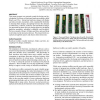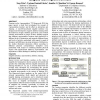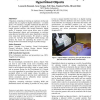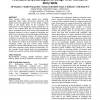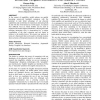TEI
2009
ACM
14 years 8 months ago
2009
ACM
This paper presents our research toward the design and development of a library of electronic hardware modules called Blades and Tiles. Interaction hardware design with blades and...
TEI
2009
ACM
14 years 8 months ago
2009
ACM
Drawing on the ‘representation’ TUI framework [21], this paper reports a study that investigated the concept of ‘representation location’ and its effect on interaction and...
TEI
2009
ACM
14 years 8 months ago
2009
ACM
This paper describes the rationale and design process for Shoebox, a “digital box” that combines the storage and display of digital images in the home in one unit. By combinin...
TEI
2009
ACM
14 years 8 months ago
2009
ACM
Ubiquitous computing is fostering an explosion of physical artifacts that are coupled to digital information – so-called Spimes. We introduce a tangible workbench that allows fo...
TEI
2009
ACM
14 years 8 months ago
2009
ACM
Many research efforts today explore how digitally augmented tables enable face-to-face interaction with digital content and applications. Yet the design of digital tables is still...
TEI
2009
ACM
14 years 8 months ago
2009
ACM
We discuss three design strategies for improving the quality of social interaction and learning with interactive museum guides: 1) embodied interaction; 2) game-learning; 3) a hyb...
TEI
2009
ACM
14 years 8 months ago
2009
ACM
In the context of tangibility, mobile phones are rapidly becoming sensor-rich handheld computers with the potential to take better advantage of our physical capabilities and our l...
TEI
2009
ACM
14 years 8 months ago
2009
ACM
Tangible User Interfaces (TUIs) are commonly accepted as those in which the configuration of physical objects embodies digital system state, providing “graspable” digital medi...
TEI
2009
ACM
14 years 8 months ago
2009
ACM
Although many augmented tabletop systems have shown the potential and usability of finger-based interactions and paper-based interfaces, they have mainly dealt with each of them ...
TEI
2009
ACM
14 years 8 months ago
2009
ACM
Surfaces capable of modulating permeability have long been used in architecture for environmental control, but have remained largely unexplored as information displays. The advent...
